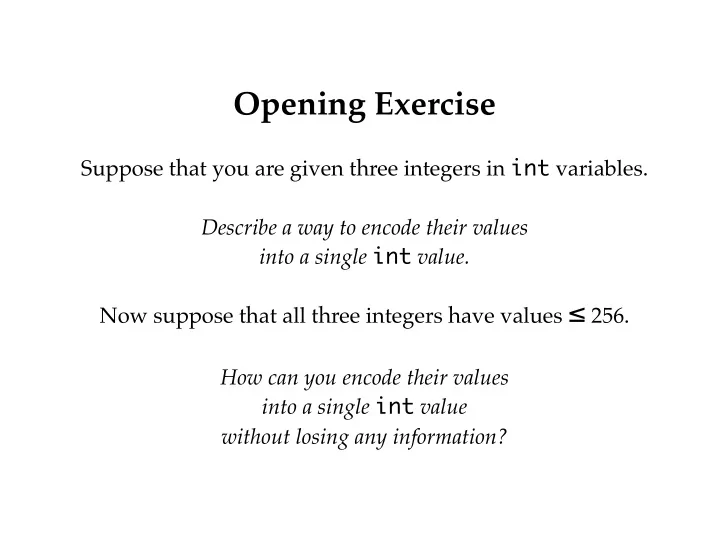

Opening Exercise Suppose that you are given three integers in int variables. Describe a way to encode their values into a single int value. Now suppose that all three integers have values ≤ 256. How can you encode their values into a single int value without losing any information?
Possible Solutions, Part 1 add the values choose the largest average the values The last of these corresponds to grayscale in an image. Is it a lossy or lossless encoding?
Possible Solutions, Part 2 > Integer.MAX_VALUE 2147483647 > 256 * 256 * 256 16777216 An integer consists of 32 bits, and each of our values takes at most 8 bits. How can we use the empty bits?
Part 2 — With 1-Digit Values
Exercise #2 Write a Pixel method named setColorFrom( int encoded ) that changes the pixel's color to the RGB values encoded in the int argument. Methods you can use in Pixel : getRed(), getGreen(), getBlue() setRed(), setGreen(), setBlue() getColor(), setColor()
Our Picture Compression Success! For a Picture of n pixels, we now require only n integers, not 3n integers. ... but.
But What? That is already how Pixel s are represented! The methods getRed() , getGreen() , getBlue() don't look up the values of variables. They compute the values upon request.
Recap: Data Compression Often we can find a way to store the same amount of information in less space — with a different encoding .
Recap: Lossy versus Lossless A compression algorithm that loses information is called lossy . A compression algorithm that retains all information is called lossless . Lossy algorithms can generate smaller files, at some cost in the quality of the file for some purposes — including decompression.
Our Idea for Compressing Sound Instead of using 2 bytes for each sample value, we could use 1 byte to record each sample change! For a Sound of size n , we now require n+1 bytes instead of 2n bytes.
Our DiffSound Class class declaration instance variables constructors methods access modifiers public versus private static versus (not)
Exercise: Decompression Write a DiffSound method named decompress() that returns a Sound object. The returned Sound should reconstruct the original set of sample values.
Javadoc as a Tool At a command-line prompt: mac os x > javadoc DiffSound.java generates the file: Di fg Sound.html mac os x > javadoc *.java generates hyperlinked documentation for all the Java source files in the current directory.
Recommend
More recommend